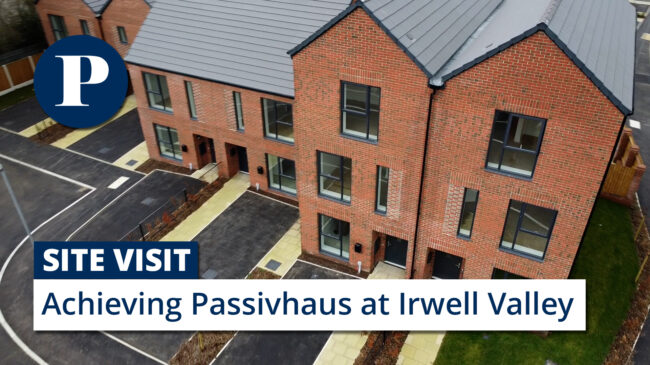Malthouse: Population uncertainty ‘not excuse to take foot off pedal’
The housing minister has described figures released by the Office for National Statistics which reduced population projections and housing targets as “very weird”, and said the Government was undertaking “urgent work” to look at the issue in order to release further guidance.
In July, population projections released by the ONS showed a slower rate of growth nationally than expected. These then had a knock-on impact on the Sub National Housing Figures announced last week, which saw the number of homes supposedly needed across the country also reduced.
Speaking to Place North West, Kit Malthouse, minister for housing, said the ONS had revealed “weird results”.
“We are taking an urgent look at these figures, because there are various issues with how they’ve been calculated, one of which being the period they’ve used to project from being one of slow growth. For instance Cambridge, a very high growth area, has been told it needs no more homes, which is ridiculous.
“The Government will be releasing guidance around this and we absolutely don’t want people to take their foot off the [housing delivery] accelerator.”
The ONS results have caused disruption to the creation of Local Plans and Spatial Frameworks.
In July, Mayor Andy Burnham said the rewrite of the Greater Manchester Spatial Framework would be delayed further in order to incorporate a response to the ONS figures, and last week there were suggestions that there would be even more delay as the city region waits for the Government guidance.
In Greater Manchester, housing targets are understood to have dropped to 154,000 homes over a 20-year period, undermining the GMSF’s goal of 211,000. This has led to debate behind the scenes between Greater Manchester’s 10 local authorities and the Mayor over whether it is better to go with the lower figure, protecting the city region’s Green Belt from release and helping Burnham stick to one of his key election pledges, or aim for a higher figure which allows room for growth, particularly in some of the northern boroughs which are calling for much-needed job creation and higher value homes.
Government “moving goalposts”
Following a meeting of the Greater Manchester Combined Authority on Friday, the 10 councils and Burnham released a joint statement:
“Greater Manchester’s Mayor and leaders have united to demand the Government acts quickly and publishes its revised methodology to determine the number of homes that the City Region would be required to build.
“Right now the Government is moving the goalposts and making this process more difficult. We have made real progress towards agreeing a rewritten Greater Manchester Spatial Framework, but this uncertainty around the housing figures is delaying our final decisions and compromising our ability to get on with strategic planning in Greater Manchester.
“The Government methodology that could give us the clarity we need is due to be published after the Conservative Party Conference – but even then, the revised methodology will only be a consultation rather than the finalised formula for assessing local housing need.
“We are clear that the Government must not fiddle the methodology to inflate the housing numbers just to meet its own artificial target. ”
Government housing figures and question marks over methodology have been the cause of much debate over the past year. Last year, when the Government released its revised method for assessing each area’s housing need, the method saw an increase in housebuilding targets for high-growth areas in the South, but a drop in targets for places in the North due to perceived lack of demand. Councils have argued that a ‘no-growth’ plan is damaging for various areas in the North, which want quality homes to attract more businesses to their areas.
Malthouse rejected the idea that the Government was restricting growth in the North in favour of the South.
“We are all about encouraging economic growth, with the Northern Powerhouse, and providing on the homes that deliver that growth. For areas with great plans like Manchester and Liverpool we absolutely think there should be houses to deliver on that ambition. Also the Objectively Assessed Need figures are really just guidance, if a local authority wants to overshoot that they’re absolutely welcome to.”
Places like Wirral were resistant even to the Government’s lower housing targets produced using the OAN method, so celebrated the drop in population and housing figures released by the Office for National Statistics.
Council leader Cllr Phil Davies quickly announced that the new numbers proved Wirral was right to tell ministers it “should not have to slavishly follow the Government’s national formula” on housing targets, which would have seen it need to release Green Belt. The ONS figures have seen Wirral’s annual target fall from 800 homes to 500.
Davies said the previous figures “were a miscalculation which threatened our Green Belt” and said he would be writing to the Government to “urge them to take these new figures into account”.





It looks like local government and central government are going to blame each other for continued inaction. This sadly will become a theme of devolution and an excuse. We need strong local leadership that should not hide behind excuses or blame central government for not being able to deliver on promises made. Manchester should be brave and set a 250,000 target for house building and get on with it ASAP. Build and they will come!
By Mystic Meg
Spot on Mystic Meg. Something new will come up next week to provide a convenient excuse for another delay. Release what they have and lets get on with it. Even if land comes out of the greenbelt, it is still greenfield and planning rules still apply. Its just another piece of red tape that NIMBY’s love to hang onto. The truth is that some areas of greenbelt are barron fields that are no use to anyone. A review should allow some of those to be brought into use. Its not always down to a developer wanting a cheap option. They are often the most logical with infrastructure close by rather than forcing development into the countryside. Lets move on….
By GravyTrain
This mess will have come as no surprise at all to government, so Malthouse is being disingenuous to ONS. Its methodology last year already resulted in figures considerably lower than its artificial target of 300,000 units per year (never hit without massive LA house building). It knew national population projections were down and therefore household projections and resultant housing requirements would fall considerably, widening the gap with 300,000. The difficulty now is what are the “fudge factors” to use to artificially inflate the numbers and for which areas. It will require careful technical explanation and some form of evidence to justify which I guess government is now scratching its head about. Of course in many districts the uplift in figures was so unbelievable compared with current delivery and land supply as to move into the realm of complete fantasy…as is the 300,000 and why it is actually from “mid 2020s…hardly a firm commitment. Of course ONS is now talking of a different set of projections in December with yet another set of assumptions will muddy the water further. Local councils need certainty now not further delays and chiding from government. Of course everyone now knows what growth the 2016 projections show, any uplift will need to be justified and no doubt in many areas the consequences and Green Belt release will be laid fully at the door of government.
By Cynical Planner
As Mystic Meg says, be prepared for inaction and Local and Central Government blaming each other. We will realise in 10 years time that devolution still isn’t working efficiently. Andy Burnham’s successor will be blaming Central Government and they will point the figure at local level. In other words it doesn’t matter whether its central or local we shall get a another version of mediocrity and incompetence from the administrators. Another fine mess Stanley…
By Stan not Ollie